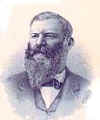|
Alexander W.
Livingston
Pioneer Seedsman and the
Father of the Modern Tomato
by Mike Dunton
[
Business History ] [
Complete List of Introductions ]
[
Available Livingston Tomato Varieties ] [
Livingston Family Tree ]
 Alexander
Livingston may not have introduced the world to the tomato, but he is
the first seedsman to methodically and intentionally develop varieties
with specific traits. He thus fostered the growth of the commercial
tomato industry in the United States. Mr. Livingston and his seed
company contributed more to the development of the tomato as a
commercial crop than any other. Alexander
Livingston may not have introduced the world to the tomato, but he is
the first seedsman to methodically and intentionally develop varieties
with specific traits. He thus fostered the growth of the commercial
tomato industry in the United States. Mr. Livingston and his seed
company contributed more to the development of the tomato as a
commercial crop than any other.
Tomatoes had been cultivated in the
Americas for millennia and integrated into European cuisine after the
earliest explorers to the “New World” returned home. However, here in
the United States, tomatoes were occasionally grown as ornamental
curiosities but rarely for consumption. They were even widely believed
to be poisonous well into the nineteenth century.
It has been speculated that that these
trends were due to the poor quality of the generally “wild” nature of
the tomatoes that were available at that time. They were described as
strong smelling and unpleasantly acidic.
By the mid-1800s, tomatoes had finally
become more popular and were developing into an important commercial
crop. This was due in part by the waves of European immigrants and their
different dietary preferences. Still, little had been done to actually
improve the quality of the species. Just a handful of named varieties
existed and most of those were being imported from England and France.
It was in this period of history that
Alexander W. Livingston was born, lived, found purpose, and celebrated
for his accomplishments.
Alexander Wilmer Livingston was born on
October 14, 1821, in Reynoldsburg, Ohio, when it was not much more than
a pioneer farming community. At the age of ten, by his own recollection,
he encountered his first tomatoes growing in a garden in the area.
Catching his attention and piquing his
youthful curiosity, he recounted that he, “. . . quickly gathered a
few of them in my hands, and took them to my mother to ask, ‘What they
were?’ As soon as she saw me with them, she cried out, ‘You must not eat
them, my child. They must be poison, for even the hogs will not eat
them.’”
Who could have guessed that this encounter
would one day not only become his calling, it would lead to his fame
among gardeners, farmers, plant breeders, tomato processors, and his
seedsman peers, worldwide.
Raised in an early nineteenth century
farming environment, formal schooling was not available. Presumably, his
parents placed importance on education because Alex learned reading,
writing, arithmetic, studied grammar, and developed a curious and
methodical nature.
As a young man he began working for a
local seed farmer. It was during this employment that he began noticing,
studying and memorizing different plant traits. Becoming a seed farmer
himself was not something he was considering at this point in his life.
A few years later in 1844, he married, and
in the natural course of starting a family, laid down roots by first
leasing land on which to farm, eventually saving enough money to buy his
own land. He set to work producing seed for the burgeoning seed
industry, began experimenting with various vegetables, and testing his
ideas based on his observations. This of course included tomatoes.
When Mr. Livingston began his attempts to
develop the tomato as a commercial crop, his goal was to produce fruits
that were smooth skinned, uniform in size and having better flavor. Most
tomato varieties at that time did not possess any of these attributes.
After many attempts at hybridization, he
began instead a process of selecting seed from tomato plants exhibiting
specific characteristics that he was interested in. While using this
selection process he discovered a plant which bore perfect tomatoes that
remained true-to-type in successive generations.
After five years of selection, the fruit
became fleshier and larger. In 1870, Alexander was happy with his new
variety, and introduced it to the world as the 'Paragon'
tomato.
Alexander was posthumously recognized for
his contributions by the United States Department of Agriculture in
their 1937 "Yearbook of Agriculture." They wrote:
"The work of A. W. Livingston, of
Columbus, Ohio, and his associates and successors in the Livingston Seed
Co. has resulted in the introduction of more new varieties than that of
any other private group. Most of the varieties introduced by the
Livingstons were of their own finding or origination . . ."
"With all due credit to the important
contributions of other growers, seedsmen, and investigators, it is not
out of place to call attention again to the great contribution of the
Livingston Seed Co. to tomato improvement."
Over the course of his working life,
Alexander Livingston introduced fifteen tomato varieties by the time he
passed away on
November 11, 1898.
Many of his introductions were used by breeders to select from, or
include in the parentage, of subsequent varieties. In all, A. W.
Livingston and his company introduced thirty-five varieties of tomatoes,
not to mention their other vegetable variety releases.
By the mid-twentieth century, most of the Livingston varieties had all
but disappeared from availability. Beginning in 1999, the Victory Seed
Company began the long process of recreating Livingston’s seed
collection. This involved locating, growing, and comparing fruit against
the historical record to ensure accuracy before reintroducing varieties.
From this preservation work, many of the Livingston’s original tomatoes
are once again available to the gardening public. You can find seeds for them by
clicking here.
[
Click
Here for Livingston Genealogical Information ]
|